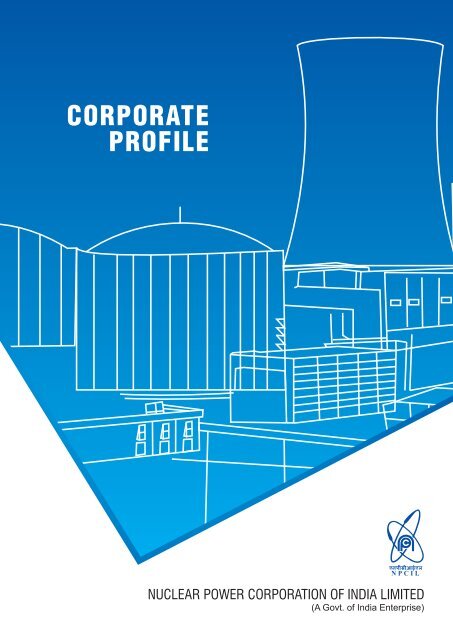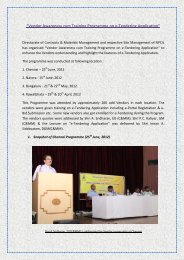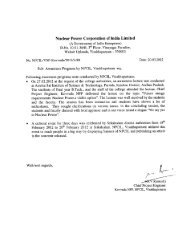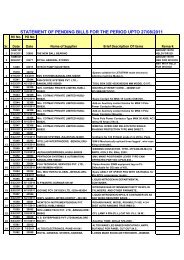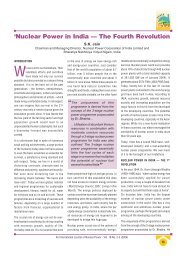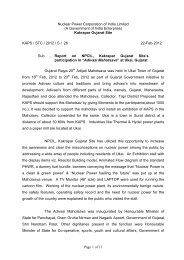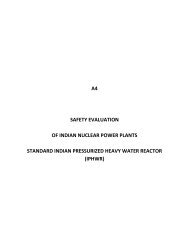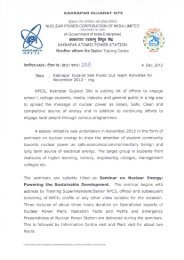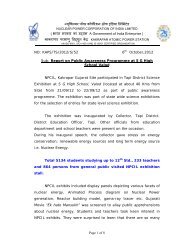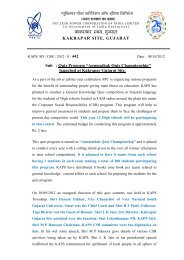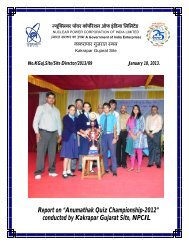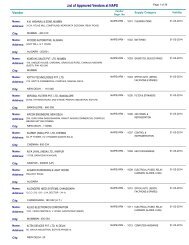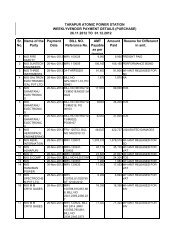NPCIL Corporate Profile - Nuclear Power Corporation of India Limited
NPCIL Corporate Profile - Nuclear Power Corporation of India Limited
NPCIL Corporate Profile - Nuclear Power Corporation of India Limited
Create successful ePaper yourself
Turn your PDF publications into a flip-book with our unique Google optimized e-Paper software.
CORPORATE<br />
PROFILE<br />
N P C I L<br />
NUCLEAR POWER CORPORATION OF INDIA LIMITED<br />
(A Govt. <strong>of</strong> <strong>India</strong> Enterprise)
1<br />
N P C I L<br />
<strong>Nuclear</strong> <strong>Power</strong> - An Inevitable Option<br />
Electricity is a basic input which is closely<br />
related to the economic development <strong>of</strong> a country. In<br />
spite <strong>of</strong> the impressive strides in increasing overall<br />
installed capacity in the country, we are still facing<br />
power shortages. Options available for commercial<br />
electricity generation are hydro, thermal, nuclear and<br />
renewables. In the energy planning <strong>of</strong> the country, a<br />
judicious mix <strong>of</strong> hydro, thermal, nuclear and<br />
renewable is an important aspect. Diversified energy<br />
resource-base is essential to meet electricity<br />
requirements and to ensure long-term energy<br />
security. With the limited resources <strong>of</strong> coal and oil<br />
available in the country and with growing global<br />
concerns <strong>of</strong> greenhouse gases generated by fossilfuel-fired-stations,<br />
nuclear power is being called<br />
upon to play a greater role in medium- and longterm<br />
perspective.<br />
Resource<br />
<strong>India</strong>'s long-term nuclear power programme is based<br />
on utilising the vast indigenous thorium resources for<br />
electricity generation. <strong>India</strong>'s uranium resources can<br />
support a first-stage programme <strong>of</strong> about 10,000 MW<br />
based on Pressurised Heavy Water Reactors (PHWRs)<br />
using natural uranium as fuel and heavy water as<br />
moderator and coolant. The energy potential <strong>of</strong> natural<br />
uranium can be increased to about 3,00,000 MW in the<br />
second stage though Fast Breeder Reactors (FBRs) which<br />
utilise plutonium obtained from the recycled spent fuel <strong>of</strong><br />
the first stage along with thorium as blanket, to produce U-<br />
233. With the deployment <strong>of</strong> thorium at third stage using U-<br />
233 as fuel, the energy potential for electricity generation is<br />
large and substantial. Indigenous industrial infrastructure<br />
for reactor programme is well- developed. Special<br />
infrastructure for the production <strong>of</strong> fuel, heavy water,<br />
reactor control and instrumentation have been developed<br />
within the Department <strong>of</strong> Atomic Energy. <strong>India</strong>n industry<br />
has gained valuable experience and reached a stage <strong>of</strong><br />
maturity in manufacturing equipment components and<br />
handling <strong>of</strong> mega package contracts for these reactors.<br />
Fossil<br />
<strong>India</strong>’s Energy Resource Base<br />
Coal<br />
Hydrocarbon<br />
Non-Fossil<br />
<strong>Nuclear</strong><br />
Uranium metal<br />
In PHWR<br />
In Fast Breeders<br />
Thorium metal<br />
In Breeders<br />
Renewable<br />
Long - Term <strong>Nuclear</strong> <strong>Power</strong> Programme<br />
Hydro<br />
Non-conv. Renewable<br />
Amount<br />
38 Billion T<br />
12 Billion T<br />
61,000 T<br />
2,25,000 T<br />
150 GW<br />
100 GW<br />
(Source: Department <strong>of</strong> Atomic Energy)<br />
Stage<br />
Natural<br />
uranium<br />
dioxide<br />
fuel<br />
131603<br />
MW<br />
Electricity Potential<br />
(GW-year)<br />
7,614<br />
5,833<br />
328<br />
42,231<br />
1,55,502<br />
69<br />
33<br />
<strong>India</strong>'s <strong>Nuclear</strong> Strategy<br />
38990<br />
MW<br />
INSTALLED CAPACITY<br />
4780<br />
MW<br />
Thermal<br />
Hydro<br />
<strong>Nuclear</strong><br />
(Source: CEA.)
N P C I L<br />
<strong>NPCIL</strong>-<strong>Power</strong> Behind <strong>Nuclear</strong> <strong>Power</strong><br />
<strong>Nuclear</strong> <strong>Power</strong> <strong>Corporation</strong> <strong>of</strong> <strong>India</strong> <strong>Limited</strong> (<strong>NPCIL</strong>)<br />
is a Public Sector Enterprise under the Department <strong>of</strong><br />
Atomic Energy (DAE), Government <strong>of</strong> <strong>India</strong>. It was<br />
incorporated on September 17, 1987 as a Public <strong>Limited</strong><br />
Company under the Companies Act 1956, with the<br />
objective <strong>of</strong> operating the atomic power stations and<br />
implementing the atomic power projects for the generation<br />
<strong>of</strong> electricity, in pursuance <strong>of</strong> the schemes and<br />
programmes <strong>of</strong> Government <strong>of</strong> <strong>India</strong> under the Atomic<br />
Energy Act.<br />
The formation <strong>of</strong> <strong>NPCIL</strong> was necessitated to give it<br />
operational flexibility and raise financial resources from<br />
the capital market to finance the setting up <strong>of</strong> the projects.<br />
The authorised share capital <strong>of</strong> the company is Rs. 15,000<br />
crores <strong>of</strong> which Rs. 10174 crores is paid up as on<br />
31/03/2012 which is fully subscribed by the Government<br />
<strong>of</strong> <strong>India</strong>.<br />
<strong>NPCIL</strong> - Mission<br />
To develop nuclear power technology and to produce nuclear power as a safe, environmentally benign and an<br />
economically viable source <strong>of</strong> electrical energy to meet the increasing electricity needs <strong>of</strong> the country.<br />
Board <strong>of</strong> Directors<br />
Generation in the year 2011-12<br />
Generation in the year 2011 -12<br />
(Status as on March 31, 2012) MUs<br />
Thermal 708806<br />
Hydro 130510<br />
Import from Bhutan 5285<br />
<strong>Nuclear</strong> 32287<br />
Total 876888<br />
Installed Capacity as on March 2012 MW<br />
Thermal 131603<br />
<strong>Nuclear</strong> 4780<br />
RES 24504<br />
Hydro 38990<br />
Total 199877<br />
th<br />
Capacity Addition in XI Plan MW<br />
Target:<br />
Realisation:<br />
78700<br />
Thermal 48540<br />
Hydro 5544<br />
<strong>Nuclear</strong> 880<br />
Total Addition 54964<br />
(Source: CEA )<br />
The business <strong>of</strong> the company (<strong>NPCIL</strong>) is managed by the Board <strong>of</strong> Directors appointed by the President <strong>of</strong> <strong>India</strong>.<br />
The Chairman and Managing Director is the Chief Executive <strong>of</strong> the company and looks after the day-to-day affairs <strong>of</strong> the<br />
company under the superintendence <strong>of</strong> the Board <strong>of</strong> Directors.<br />
<strong>NPCIL</strong> at a Glance th<br />
Date Of Establishment 17 September,1987<br />
Authorised Share Capital Rs. 15,000 crores<br />
Paid Up Capital (31/03/2012) Rs. 10,174 crores<br />
Number <strong>of</strong> Units in Commercial operation 19*<br />
Total Installed Capacity *<br />
4680<br />
MW<br />
* in addition to these units, RAPS-1 (100 MW) is owned by the Department <strong>of</strong> Atomic Energy and managed by <strong>NPCIL</strong><br />
2
3<br />
N P C I L<br />
Success Stories<br />
� Repair <strong>of</strong> the Over-Pressure Relief Device (OPRD)<br />
<strong>of</strong> Rajasthan Atomic <strong>Power</strong> Station unit-1 (RAPS-1)<br />
� Enmasse Coolant Channel Replacement (EMCCR)<br />
and Safety Upgradation was carried out for the first<br />
time in RAPS-2, totally with indigenous efforts.<br />
Subsequently, EMCCR was carried out in five more<br />
reactors - MAPS 1&2, NAPS 1&2 and KAPS-1.<br />
� Restoration <strong>of</strong> MAPS 1&2 to their original rating <strong>of</strong><br />
220 MW by innovative solution <strong>of</strong> spargers.<br />
� Enmasse Feeder Replcement (EMFR) carried out<br />
for the first time in the world in a PHWR at MAPS-1.<br />
Subsequently EMFR carried out at RAPS-2, NAPS<br />
1&2 and KAPS-1<br />
� Detection and successful Repair <strong>of</strong> leak in<br />
Calandria Vault <strong>of</strong> KAPS-1 (high radiation field area)<br />
carried out by indigenously developed remote tools<br />
& technology, in parallel with EMCCR & EMFR.<br />
� The complex task <strong>of</strong> core shroud inspection was<br />
carried out successfully for TAPS, with remote<br />
handling tools developed indigenously by DAE/<br />
<strong>NPCIL</strong>. These units are operating for more than 40<br />
years. Plant life extension works are being carried<br />
out progressively.<br />
Performance Highlights<br />
� During the year 2011-12, <strong>NPCIL</strong> achieved its<br />
highest ever generation <strong>of</strong> 32,455 Million Units <strong>of</strong><br />
electricity. The generation was 23% higher than<br />
that in 2010-11 (26473 MUs).<br />
� The nuclear power reactors under IAEA<br />
safeguards, for which imported fuel is available in<br />
the required quantity, operated with overall 97%<br />
capacity factor.<br />
� The overall Availability Factor <strong>of</strong> the reactors in<br />
operation continued to be high at 91% during the<br />
year.<br />
� Tarapur Atomic <strong>Power</strong> Station unit-3 (TAPS-3), 540<br />
MW Pressurized Heavy Water Reactor (PHWR),<br />
achieved a continuous operation for 522 days, thus<br />
joining the fleet <strong>of</strong> 9 nuclear power reactors which<br />
have earlier recorded continuous operation over<br />
one year.<br />
� During the year 2011-12, <strong>NPCIL</strong>’s Pr<strong>of</strong>it After<br />
Tax(PAT) was Rs. 1906 crore, 39% higher than the<br />
last year’s pr<strong>of</strong>it <strong>of</strong> Rs. 1376 crore in view <strong>of</strong> higher<br />
generation<br />
� A dividend <strong>of</strong> Rs. 572 crore for the year paid to the<br />
Govt. <strong>of</strong> <strong>India</strong><br />
� <strong>NPCIL</strong>'s instruments continued to be maintained at<br />
AAA rating<br />
� The safety record <strong>of</strong> <strong>NPCIL</strong> was maintained<br />
impeccable over 362 cumulative reactor-years <strong>of</strong><br />
safe, accident free operation<br />
� Three projects namely KKNPP - 1 & 2 (2 X 1000<br />
MW LWRs), KAPP - 3 & 4 ( 2X 700 MW PHWRs)<br />
and RAPP - 7 & 8 (2 X 700 MW PHWRs) are under<br />
various stages <strong>of</strong> construction and commissioning.<br />
KKNPP Unit - 1 have been made ready for fuel<br />
loading.<br />
� The Public outreach has been accorded a high<br />
priority and necessary organizational structures<br />
and mechanisms have been enhanced.<br />
� Pre-project activities like MoEF clearance, land<br />
acquisition, site infrastructure development works,<br />
etc. are in various stages <strong>of</strong> progress at green field<br />
sites in Haryana, Madhya Pradesh, Andhra<br />
Pradesh, Gujarat, Rajasthan and West Bengal.
N P C I L<br />
DETAILS OF OPERATING REACTORS (TOTAL 4780 MW)<br />
Operating Reactors Type <strong>of</strong> Reactor Rated Capacity MW Location Commercial Operation<br />
TAPS-1<br />
TAPS-2<br />
TAPS-3<br />
TAPS-4<br />
RAPS-1<br />
RAPS-2<br />
RAPS-3<br />
RAPS-4<br />
RAPP-5<br />
RAPP-6<br />
MAPS-1<br />
MAPS-2<br />
NAPS-1<br />
NAPS-2<br />
KAPS-1<br />
KAPS-2<br />
KAIGA-1<br />
KAIGA-2<br />
KAIGA-3<br />
KAIGA-4<br />
Projects<br />
Kudankulam-1<br />
Kudankulam-2<br />
Fast Breeder*<br />
KAPP - 3<br />
KAPP - 4<br />
RAPP - 7<br />
RAPP - 8<br />
* Being implemented by BHAVINI<br />
Particulars<br />
Generation (MUs)<br />
Availability Factor, %<br />
CRISIL Credit Rating<br />
BWR<br />
BWR<br />
PHWR<br />
PHWR<br />
PHWR<br />
PHWR<br />
PHWR<br />
PHWR<br />
PHWR<br />
PHWR<br />
PHWR<br />
PHWR<br />
PHWR<br />
PHWR<br />
PHWR<br />
PHWR<br />
PHWR<br />
PHWR<br />
PHWR<br />
PHWR<br />
160<br />
160<br />
540<br />
540<br />
100<br />
200<br />
220<br />
220<br />
220<br />
220<br />
220<br />
220<br />
220<br />
220<br />
220<br />
220<br />
220<br />
220<br />
220<br />
220<br />
Tarapur<br />
(Maharashtra)<br />
Rawatbhata<br />
(Rajasthan)<br />
Kalpakkam<br />
(Tamil Nadu)<br />
Narora<br />
(U.P.)<br />
Kakrapar<br />
(Gujarat)<br />
Kaiga<br />
(Karnataka)<br />
Reactors under Construction (Total 5300 MW)<br />
2004-2005<br />
16709<br />
88<br />
AAA<br />
Highest<br />
Safety<br />
Type <strong>of</strong><br />
Reactor<br />
VVER<br />
VVER<br />
PFBR 500<br />
PHWR<br />
PHWR<br />
PHWR<br />
PHWR<br />
Peformance <strong>of</strong> <strong>NPCIL</strong><br />
Rated Capacity<br />
(MW)<br />
1000<br />
1000<br />
700<br />
700<br />
700<br />
700<br />
28/10/1969<br />
28/10/1969<br />
18/08/2006<br />
12/09/2005<br />
16/12/1973<br />
01/04/1981<br />
01/06/2000<br />
23/12/2000<br />
04/02/2010<br />
31/03/2010<br />
27/01/1984<br />
21/03/1986<br />
01/01/1991<br />
01/07/1992<br />
06/05/1993<br />
01/09/1995<br />
16/11/2000<br />
16/03/2000<br />
05/05/2007<br />
20/01/2011<br />
Location<br />
Kudankulam<br />
(Tamil Nadu)<br />
Kalpakkam<br />
(Tamil Nadu)<br />
Kakarapar<br />
(Gujarat)<br />
Rawatbhata<br />
(Rajasthan)<br />
2005-2006 2006-2007 2007-2008 2008-2009 2009-2010 2010-2011 2011-2012<br />
17324 18804 16956 14927 18831 26473 32455<br />
89 85 83 82 92 89 91<br />
AAA<br />
Highest<br />
Safety<br />
AAA<br />
Highest<br />
Safety<br />
AAA<br />
Highest<br />
Safety<br />
AAA<br />
Highest<br />
Safety<br />
AAA<br />
Highest<br />
Safety<br />
AAA<br />
Highest<br />
Safety<br />
AAA<br />
Highest<br />
Safety<br />
4
5<br />
N P C I L<br />
ISO-14001 and IS-18001 Certification:<br />
All the nuclear power stations namely Narora, Kakrapar, Tarapur, Kalpakkam, Rajasthan and Kaiga have been<br />
certified for ISO-14001 (Environment Management System) and IS-18001 (Occupational Health and Safety<br />
Management System).<br />
This certification provides for :<br />
� Compliance with applicable environmental legislation and regulations along with a commitment for continual<br />
improvement.<br />
� Improved corporate commitment to environmental protection and conservation <strong>of</strong> resources.<br />
Typical ESL at one <strong>of</strong> the <strong>Nuclear</strong> <strong>Power</strong> Plants <strong>of</strong> <strong>NPCIL</strong><br />
10.15<br />
39.60<br />
3.12<br />
0.42<br />
0.75<br />
1.47<br />
1000<br />
2400<br />
0<br />
TAPS RAPS MAPS NAPS KAPS KGS AERB Natural<br />
LIMIT Average<br />
2500<br />
2000<br />
1500<br />
1000<br />
Average Radiation Dose from NPPs at 1.6 Km for Year (2010)<br />
500<br />
Dose Micro Sievert/year (µSv/y)<br />
Ensuring Environmental<br />
Protection<br />
Protection <strong>of</strong> the plant personnel, the<br />
environment and the public is an important<br />
consideration in the design, construction and<br />
operation <strong>of</strong> the nuclear power stations. The<br />
radiation source is adequately shielded, monitored<br />
in all operation and constantly maintenance works<br />
on the active systems are carried out strictly<br />
according to approved procedures.<br />
The release <strong>of</strong> radioctivity to the environment<br />
from nuclear power stations is in very small<br />
quantities, in any case well within the limits<br />
stipulated by the Atomic Energy Regulatory Board<br />
(AERB). The radiation dose due to actual releases is<br />
insignificant compared to the dose that from the<br />
natural radiation background. A person living at the<br />
fence post <strong>of</strong> a nuclear power station receives a<br />
radiation dose in 20 years equivalent to the radiation<br />
dose <strong>of</strong> a single chest X-ray indicating the adequacy<br />
<strong>of</strong> radiation control in nuclear power plants.<br />
It is interesting to compare the radiation<br />
exposures resulting from the operation <strong>of</strong> a nuclear<br />
power plant in <strong>India</strong> to the unavoidable natural<br />
background radiation exposure. Detailed surveys<br />
have shown that normal natural background<br />
radiation in different parts <strong>of</strong> the country varies from
N P C I L<br />
2.07 mSv/year (a unit for radiation measurement) at Tarapur in Maharashtra to 3.1 mSv/yr at Narora in Uttar<br />
Pradesh. It is estimated that annual average maximum individual exposure at a plant boundary <strong>of</strong> nuclear power<br />
stations is less then 0.1 mSv/year. These small additional exposures are indistinguishable in the large variation <strong>of</strong><br />
natural background that are observed and have no impact whatsoever on the health <strong>of</strong> the population.<br />
Environment Survey Laboratory with advanced monitoring equipments are set-up at each <strong>of</strong> the sites,<br />
before commissioning <strong>of</strong> the nuclear plants. These ESLs monitor, environmental matters like air, water, soil, crop,<br />
vegetation, fish, meat, food stuff etc., upto an area <strong>of</strong> 30 kms radius form the plant for radioactivity. The background<br />
level <strong>of</strong> radiation is established for comparison after commissioning <strong>of</strong> the plants. The data from the ESLs over the<br />
last 43 years <strong>of</strong> operation <strong>of</strong> nuclear power plants in <strong>India</strong> has shown that, there is no significant rise in radioactivity<br />
due to the operation <strong>of</strong> nuclear power plants over the natural background radiation.<br />
Safety <strong>of</strong> <strong>Nuclear</strong> <strong>Power</strong> Stations<br />
Safety has been given paramount importance in design,<br />
construction and operation <strong>of</strong> nuclear power stations. To<br />
ensure the safety <strong>of</strong> reactor, a defence-in-depth philosophy is<br />
followed, which leads to multiple barriers, diversity,<br />
redundancy, independence and fail-safe design <strong>of</strong> the safetyrelated<br />
systems. Safety <strong>of</strong> nuclear power stations is further<br />
ensured through sound design, using international standards<br />
and codes, stringent quality assurance, approved operating<br />
procedures, in-service inspection and maintenance <strong>of</strong> safety<br />
systems, etc.<br />
ACCIDENT<br />
INCIDENT<br />
DEVIATION<br />
0<br />
2<br />
1<br />
3<br />
5<br />
4<br />
6<br />
7<br />
Major Accident<br />
Serious Accident<br />
Accident with <strong>of</strong>f-site risk<br />
Accident without<br />
significant <strong>of</strong>f-site risk<br />
Serious incident<br />
Incident<br />
Anomaly<br />
No safety<br />
significant<br />
International <strong>Nuclear</strong> Event Scale (INES)<br />
PRIMARY<br />
CONTAINMENT<br />
FUEL<br />
CLADDING<br />
EXCLUSION ZONE<br />
(Not to scale)<br />
SECONDARY<br />
CONTAINMENT<br />
FUEL<br />
HEAT<br />
TRANSPORT<br />
SYSTEM<br />
International <strong>Nuclear</strong> Event Scale<br />
International Atomic Energy Agency (IAEA) classifies<br />
nuclear events in the International <strong>Nuclear</strong> Event Scale<br />
(INES). INES is a 0 to 7 point scale. Events at level 0 are<br />
‘deviations’ and have no safety significance. Events <strong>of</strong> level 1<br />
to 3 are ‘incidents’. Events <strong>of</strong> level 4 to 7 are ‘accidents’. In<br />
<strong>India</strong>, no nuclear accident as defined by INES <strong>of</strong> IAEA has<br />
occurred so far over 362 reactor years <strong>of</strong> operation.<br />
6
7<br />
N P C I L<br />
<strong>Nuclear</strong> Waste Management<br />
A unique feature <strong>of</strong> nuclear power plants is the generation <strong>of</strong><br />
extremely low quantity <strong>of</strong> radioactive waste. The spent fuel containing most<br />
<strong>of</strong> the high level radioactivity is not considered waste as it produces<br />
valuable fuel for future reactors. Spent fuel is sent for reprocessing for the<br />
extraction <strong>of</strong> plutonium, uranium and other useful isotopes. High-level<br />
waste is immobilised by vitrification in glass matrix, encapsulated in<br />
stainless steel double- walled canisters and kept for interim storage for about 30 years under surveillance in concrete<br />
vault lined with stainless steel for decay <strong>of</strong> radioactivity. Ultimately waste is disposed <strong>of</strong>f in deep underground geological<br />
repository with protective barriers.<br />
During the process <strong>of</strong> generation <strong>of</strong> electricity, small quantity <strong>of</strong> low- and intermediate-level solid wastes are<br />
produced in nuclear power stations. After treatment, these wastes are disposed <strong>of</strong>f within the plant premises in earthen<br />
trenches, reinforced cement concrete trenches or tile-holes, depending upon the radiation levels. Bore-holes are made<br />
around the disposal site for sample collection and analysis to ensure no leakage <strong>of</strong> radioactivity to the outside.<br />
Small quantities <strong>of</strong> very low levels <strong>of</strong> gaseous and liquid radioactive wastes are also produced in nuclear power<br />
stations. Gaseous wastes are filtered, monitored and disposed <strong>of</strong>f through a 100-m tall stack. Liquid wastes are diluted<br />
and generally sent to water body and are monitored. The radioactivity levels <strong>of</strong> gaseous and liquid wastes disposed <strong>of</strong>f,<br />
are very low compared to regulatory stipulations. The impact <strong>of</strong> these wastes on the environment is estimated to be less<br />
than 1% <strong>of</strong> the stipulated dose limit for the general public.<br />
International Co-operation<br />
The volume <strong>of</strong> high level waste generated in a day for<br />
supplying electricity to a metro like Mumbai or Delhi<br />
would be (just 6 kg), about the volume <strong>of</strong> 2 bricks.<br />
With the successful conclusion <strong>of</strong> International cooperation the isolation <strong>of</strong> <strong>India</strong> from the world<br />
nuclear community has ceased and has paved way for global nuclear commerce including the fuel supply<br />
and setting up <strong>of</strong> Light water reactors <strong>of</strong> 1000 MW or larger size capacity in <strong>India</strong>.<br />
The international cooperation has enabled import <strong>of</strong> fuel for use in reactors to be placed under<br />
safeguards in accordance with the Separation Plan. Contracts for supply <strong>of</strong> fuel, 300 tons from AREVA,<br />
France and 2000 tons from TVEL, Russian Federation, and 2000 tons from Kazakhstan have been<br />
concluded. Presently nine reactors – TAPS 1&2, RAPS 2 to 6 and KAPS 1&2 with a total capacity <strong>of</strong> 1840<br />
MW are fuelled by imported fuel and are operating at full power.<br />
<strong>NPCIL</strong> has signed MoUs with Areva, GE Hitachi (GEH) and Westinghouse Electric Company<br />
(WEC) for setting up nuclear power plants in the country based on technical cooperation. <strong>NPCIL</strong> is in<br />
discussion with these companies and also with Atomstroyexport (ASE) <strong>of</strong> Russian Federation to arrive at<br />
detailed project proposals for setting up nuclear power plants <strong>of</strong> their respective technologies in <strong>India</strong>.
N P C I L<br />
Future <strong>Nuclear</strong> <strong>Power</strong> Programme<br />
The present nuclear power capacity in the country is 4780 MW. With the completion <strong>of</strong> the projects under<br />
construction (KKNPP-1&2 – 2x1000 MW at Kundankulam, Tamil Nadu, KAPP- 3&4 – 2x700 MW at Kakrapar, Gujarat<br />
and RAPP- 7&8 – 2x700 MW at Rawatbhata, Rajasthan) and Proto type Fast Breeder Reactor (PFBR) <strong>of</strong> 500 MW at<br />
Kalpakkam, Tamil Nadu, the nuclear power capacity will reach to 10080 MW by the year 2017. Design <strong>of</strong> the 700-MW<br />
PHWRs has been evolved in <strong>NPCIL</strong>.<br />
The inland sites at Gorakhpur in Haryana, Chutka and Bhimpur in Madhya Pradesh, Mahi Banswara in Rajasthan<br />
and Kaiga 5 & 6 in Karnataka have been approved "In-Principle", by the government for setting up indigenous 700 MW<br />
PHWRs. The import option in addition to the indigenous programme opens up the possibility <strong>of</strong> significant capacity<br />
addition. In addition to the inland sites for indigeneious 700 MW PHWRs, costal sites at three locations at Chhayamithi<br />
Virdi in Gujarat, Haripur in West Bengal and Kovvada in Andhra Pradesh for setting up <strong>of</strong> 1000 MW or larger capacity<br />
LWRs based on International Cooperation, have been approved 'In Principle' by the Government in October 2009. The<br />
Government has also accorded approval for the full potential <strong>of</strong> Kudankulam (6x1000MW) and Jaitapur (6x1650MW)<br />
sites. Currently Pre-project activities are going on at these sites.<br />
Projected <strong>Nuclear</strong> <strong>Power</strong> Capacity up to 12th Plan (March 2017)<br />
Details <strong>of</strong> Reactor Units Total Capacity (MW)<br />
REACTORS IN OPERATION 4780<br />
2 BWRs (2x160 MW), 18 PHWRs<br />
(1x100, 1x200, 14x220, 2x540) MW<br />
REACTORS UNDER CONSTRUCTION (Presently)<br />
5300<br />
VVERs (2x1000) MW 2000<br />
PFBR (1x500) MW* 500<br />
4 PHWRs (4x700) MW 2800<br />
* Being implemented by BHAWINI<br />
Kakrapar<br />
2x220<br />
2x700<br />
Tarapur<br />
2x160<br />
2x540<br />
Kaiga<br />
4x220<br />
Narora<br />
2x220<br />
Rawatbhata<br />
1x100<br />
1x200<br />
4x220<br />
2x700<br />
Kalpakkam<br />
2x220<br />
1x500<br />
Kudankulam<br />
2x1000<br />
In Operation<br />
- 20 Units - 4780 MWe<br />
Under Construction<br />
- 7 Units - 5300 MWe<br />
(Note to Scale)<br />
TOTAL 10080<br />
This location is for the<br />
illustrative purpose,<br />
showing only the numbers<br />
and approximate locations<br />
<strong>of</strong> nuclear power plants.<br />
8
9<br />
N P C I L<br />
LIST OF MOUs and Agreements by <strong>NPCIL</strong><br />
� <strong>NPCIL</strong> and BHEL (Bharat Heavy<br />
Electricals Ltd.) signed a<br />
Memorandum <strong>of</strong> Understanding<br />
(MoU) on April 04, 2008 to form a<br />
Joint Venture Company (JVC) for<br />
carrying out Engineering,<br />
Procurement and Construction<br />
activities for Conventional Island<br />
<strong>of</strong> <strong>Nuclear</strong> <strong>Power</strong> Plants.<br />
� <strong>NPCIL</strong> and L&T formed a JV on<br />
September 01, 2010 for special<br />
steel s and heavy forging.<br />
� The JVC company Anushakti<br />
Vidhyut Nigam <strong>Limited</strong> between<br />
<strong>NPCIL</strong> and NTPC (National<br />
Thermal <strong>Power</strong> <strong>Corporation</strong> Ltd) is<br />
incorporated on January 27, 2011<br />
for setting up <strong>Nuclear</strong> <strong>Power</strong><br />
Plants.<br />
� The JVC company <strong>Nuclear</strong><br />
Energy <strong>Corporation</strong> Ltd between<br />
<strong>NPCIL</strong> and <strong>India</strong>n Oil<br />
incorporated on April 06, 2011 for<br />
setting up <strong>Nuclear</strong> <strong>Power</strong> Plants.<br />
� The JVC company <strong>NPCIL</strong>-<br />
NALCO <strong>Power</strong> Company Ltd<br />
between <strong>NPCIL</strong> and NALCO<br />
(National Aluminium Company<br />
<strong>Limited</strong>) is incorporated on March<br />
02, 2012 for setting up <strong>Nuclear</strong><br />
<strong>Power</strong> Plants.<br />
� <strong>NPCIL</strong> and THDC (Tehri Hydro<br />
Development <strong>Corporation</strong> Ltd.)<br />
signed MoU on February 27, 2007<br />
to cooperate and collaborate for<br />
Development <strong>of</strong> Hydroelectric<br />
projects.<br />
� <strong>NPCIL</strong> and KAZATOMPROM,<br />
Russia signed MoU on January<br />
24, 2009 for cooperation in<br />
<strong>Nuclear</strong> Industry<br />
� <strong>NPCIL</strong> and AREVA, France<br />
signed Agreement on February<br />
04, 2009 for setting up EPRs in<br />
<strong>India</strong><br />
� <strong>NPCIL</strong> and ITER signed MoU on<br />
February 12, 2009 for cooperation<br />
for ITER Projects<br />
� <strong>NPCIL</strong> and GEH (GE Hitachi<br />
<strong>Nuclear</strong> Energy), USA signed a<br />
MoU on March 20, 2009 for<br />
ABWRs in <strong>India</strong><br />
� <strong>NPCIL</strong> and WEC (Westinghouse<br />
Electric Company), USA signed<br />
MoU on May 28, 2009 for setting<br />
up AP1000 reactors in <strong>India</strong><br />
� <strong>NPCIL</strong> and Bombay Natural<br />
History Society(BHNS) <strong>India</strong>,<br />
singed a MoU to meet the long<br />
term objectives <strong>of</strong> Environmental<br />
Stewardship Programme (ESP)<br />
being pursued by <strong>NPCIL</strong> on July<br />
16, 2009<br />
� <strong>NPCIL</strong> and KEPCO (Korea<br />
Electric <strong>Power</strong> <strong>Corporation</strong>),<br />
Korea signed MoU on August 27,<br />
2009 for covering bilateral<br />
cooperation in <strong>Nuclear</strong> power<br />
� MoU between <strong>NPCIL</strong> and Rural<br />
Electrification <strong>Corporation</strong> Ltd<br />
(REC) signed on October 18,<br />
2010 for funding capital outlay and<br />
financial services.<br />
� <strong>NPCIL</strong> and <strong>Power</strong> Finance<br />
<strong>Corporation</strong> Ltd (PFC) signed a<br />
MoU on October 28, 2010<br />
� <strong>NPCIL</strong> and Electronics<br />
<strong>Corporation</strong> Of <strong>India</strong> Ltd(ECIL)<br />
signed a MoU on December 03,<br />
2010<br />
� <strong>NPCIL</strong> and Engineers <strong>India</strong> Ltd<br />
(EIL) signed a Memorandum <strong>of</strong><br />
Cooperation (MoC) on February<br />
01, 2011
N P C I L<br />
<strong>NPCIL</strong>’s - Plants under operation and construction<br />
Tarapur Atomic <strong>Power</strong> Station Units 1 & 2<br />
2 x160 MW, Tarapur, Maharashtra<br />
Narora Atomic <strong>Power</strong> Station Units 1 & 2<br />
2 x 220 MW, Narora, Uttar Pradesh<br />
Kaiga Generating Station Units 1 - 4<br />
4 x 220 MW, Kaiga, Karnataka<br />
Kudankulam Atomic <strong>Power</strong> Project Units 1 & 2<br />
2 x 1000 MW, Kundankulam, Tamil Nadu<br />
Rajasthan Atomic <strong>Power</strong> Station Units 1 & 2<br />
100 MW, 200 MW, Rawatbhata, Rajasthan<br />
Kakrapar Atomic <strong>Power</strong> Station Units 1 & 2<br />
2 x 220 MW, Kakrapar, Gujarat<br />
Tarapur Atomic <strong>Power</strong> Station Units 3 & 4<br />
2 x 540 MW, Tarapur, Maharashtra<br />
Kakrapar Atomic <strong>Power</strong> Project Units 3 & 4<br />
2 x 700 MW, Kakrapar, Gujarat<br />
Madras Atomic <strong>Power</strong> Station Units 1 & 2<br />
2 x 220 MW, Kalpakkam, Tamil Nadu<br />
Rajasthan Atomic <strong>Power</strong> Station Units 3 & 4<br />
2 x 220 MW, Rawatbhata, Rajasthan<br />
Rajasthan Atomic <strong>Power</strong> Station Units 5 & 6<br />
2 x 220 MW, Rawatbhata, Rajasthan<br />
Rajasthan Atomic <strong>Power</strong> Project Units 7 & 8<br />
2 x 700 MW, Rawatbhata, Rajasthan<br />
10
N P C I L<br />
Published by:<br />
Directorate <strong>of</strong> <strong>Corporate</strong> Planning & <strong>Corporate</strong> Communications (CP&CC)<br />
6-S-14, Vikram Sarabhai Bhawan, Anushakti Nagar, Mumbai- 400094<br />
E-mail: cpcc@npcil.co.in<br />
Website: www.npcil.nic.in<br />
August 2012


